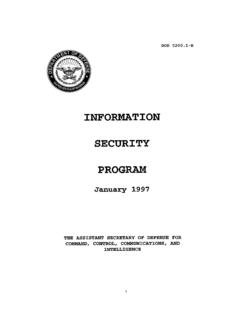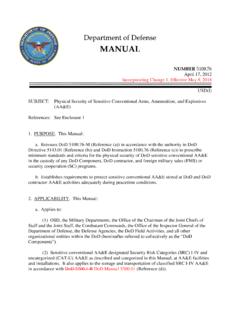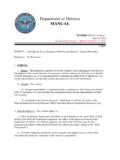Transcription of DoD 5100.76-M, August 12, 2000 - GSA Container
1 1. DoD , August 12, 2000. 2 FOREWORD. DoD , August 12, 2000. TABLE OF CONTENTS. Page FOREWORD 2. TABLE OF CONTENTS 3. LIST OF TABLES 5. REFERENCES 6. DEFINITIONS 7. CHAPTER 1 - General Information 11. Purpose 11. Scope 11. Responsibilities 13. Information Requirements 15. CHAPTER 2 - Policy 16. General 16. Intrusion Detection Systems (IDS) 17. security Forces 19. Restricted Area Posting 20. Key and Lock Control 20. Entry Control 21. Waivers and Exceptions 22. CHAPTER 3 - Protection of Category I, II, and III Missiles and Rockets and All Categories of 24. Ammunition and Explosives (A&E). Bulk Storage Areas (Depot Activities/Munitions Supply Points) 24. Unit Level (Basic Load Quantities or Quantities Sufficient for Training and Operational 25.)
2 Purposes). CHAPTER 4 - Protection of Category II, III, and IV Arms 28. General 28. Exceptions 28. Arms Parts 29. Facilities Located Outside a Military Installation 29. Issuance of Arms 29. CHAPTER 5 - Accountability, Disposal, Demilitarization, and Serial Number Registration 31. Catergory I Missiles and Rockets (Nonnuclear) 31. 3 TABLE OF CONTENTS. DoD , August 12, 2000. Category II and III Missiles and Rockets (Nonnuclear) 31. Category II, III, and IV Arms 32. Ammunition and Explosives (All Categories) 33. Inventory Adjustments 33. Disposal and Demilitarization 33. Inventories When the Responsibility for the Custody of Keys to Unit Level Arms Storage 34. Facilities Is Transferred Between Authorized Persons CHAPTER 6 - Transportation 35.
3 General 35. Responsibilities 36. Standards 36. Special Considerations for Category I Items 37. Special Considerations for Water Shipments 38. Special Considerations for Small Quantity Shipments 39. security of Commercial Shipments Temporarily at DoD Instalations and Activities 39. Overseas In-Theater Movements 39. AA&E Shipments from Defense Contractors 39. Foreign Military Sales (FMS) 40. Tabular Display of In-Transit security Requirements 40. CHAPTER 7 - Transportation 41. General 41. Incident Reports to DoD Components 41. Incident Reports to the Office of the Secretary of Defense 41. DoD Component Records 42. Annual Report 43. Other Required Reporting 43. APPENDIX 1 - Sensitive, Conventional, Arms, Ammunition, and Explosives Risk Categories 45.
4 General 45. Missiles and Rockets 46. Arms 46. Ammunition and Explosives 48. Computation of Risk Factor Numerical Values 49. Decision Logic Tables 49. APPENDIX 2 - physical security Standards for AA&E at Contractor-Owned Facilities 51. Facility Construction 51. Facility Suitability Determination 52. security Locks and Hasps 52. Key and Lock Control 53. Access Control 53. security Lighting 53. Perimeter Fencing 53. 4 TABLE OF CONTENTS. DoD , August 12, 2000. Intrusion Detection System (IDS)/Alarm System 54. AA&E Production Line security 56. In-Transit security 57. Classified AA&E 57. Accountability 57. Disposal and/or Demilitarization of AA&E 57. Arms Parts 58. Incident Reports 58. Waivers 59. Exceptions 59.
5 Standing Practice Procedures (SPP) 59. Attachement 1 - Cognizant Defense security Service Regions 60. APPENDIX 3 - physical security of AA&E at Military Terminals 62. General 62. Protection Priorities 62. Risk Category Identification 62. Temporary Storage (Less than 30 Days) 62. Cargo Movement 63. Terminal Area security 63. Seals and Twists 64. Guard Communications 64. Terminal Entry Controls 64. APPENDIX 4 - Bureau of Alcohol, Tobacco and Firearms Munitions Loss Worksheet 65. Bureau of Alcohol, Tobacco and Firearms ATF Form (4-91) 65. LIST OF TABLES. Decision Logic Table #1 - Risk Factor Numerical Values 49. Decision Logic Table #2 - Utility Risk Factor Values 49. Decision Logic Table #3 - Casualty or Damage Risk Factor Values 49.
6 Decision Logic Table #4 - Adaptability Risk Factor Values 50. Decision Logic Table #5 - Portability Risk Factor Values 50. 5 TABLE OF CONTENTS. DoD , August 12, 2000. REFERENCES. (a) DoD Directive , " physical security Review Board," February 10, 1981. (b) Military Specification MIL-P-43607G, "Padlock, Key Operated, High security , Shrouded Shackle," June 18, 1986 with Amendment 4, June 8, 1992. (c) Military Specification MIL-H-29181B, "Hasp, High security , Shrouded, For High and Medium security Padlock," May 10, 1994. (d) DoD Instruction , "Pollution Prevention," June 18, 1996. (e) DoD , "DoD Ammunition and Explosives Safety Standards," August 1997. (f) DoD , "DoD physical security Program," May 13, 1991.
7 (g) Underwriters Laboratory Standard 768, "Combination Locks". (h) DoD , "Defense Transportation Regulation, Part II, Cargo Movement,". April 1, 1996. (i) DoD , "Procedures for Management of Information Requirements," June 1998. (j) DoD , "DoD Personnel security Program," January 1987. (k) DoD , "DoD Material Management Regulation," May 1, 1998. (l) DoD , "National Industrial security Program Operating Manual,". January 1995. (m) Naval Facilities Engineering Service Center Technical Data Sheet 82-12, May 1985. (n) MIL-HDBK-1013/1A, "Design Guidelines for physical security of Facilities,". June 28, 1993. (o) DoD , "Defense Reutilization and Marketing Manual," March 1990. (p) DoD , "Information security Program," January 17, 1997.
8 (q) DoD , " security Assistance Management Manual," October 1998. (r) DoD Directive , "Chemical Agent security Program," October 15, 1986. (s) DoD , "Department of Defense Contractors Safety Manual for Ammunition and Explosives," September 1997. (t) Underwriters Laboratory Standard 2050, "National Industrial security Systems for the Protection of Classified Material". (u) Underwriters Laboratory Standard 681, "Installation and Classification of Burglar and Holdup Alarm Systems". (v) Underwriters Laboratory Standard 1076, "Proprietary Burglar Alarm Units and Systems". (w) Underwriters Laboratory Standard 827, "Central Station Alarm Services". 6 REFERENCES. DoD , August 12, 2000. DL1. DEFINITIONS. Binary Intermediates.
9 The component chemicals that combine to produce binary chemical agents. Chemical Agent. A chemical substance intended for use in military operations to kill, seriously injure, or incapacitate a person through its physiological effects. Excluded are riot control agents, chemical herbicides, smoke, and flame munitions. Constant Surveillance. Observing or protecting a storage facility or area containing AA&E by a human, intrusion detection system, closed circuit television, or combination to prevent unobserved access, or make known any unauthorized access to the facility or area during non-duty hours. Container Express (CONEX). A reusable Container for shipment of troop support cargo, quasi-military cargo, household goods, or personal baggage.
10 Container . A box or other device in which cargo is stored, protected, and handled as a unit in transit; for example: CONEX, MILVAN, SEAVAN and other approved commercial containers. This term also is used interchangeably with the term "containerization" to mean shipping that uses containers that can easily be transferred between trucks, trains, or ships without handling of contents. Defense Transportation System (DTS). Consists of military-controlled terminal facilities, Military Traffic Management Command (MTMC), Air Mobility Command (AMC)-controlled airlift, Military Sealift Command (MSC)-controlled or arranged sealift, and Government-controlled air or land transportation. Exception. An approved deviation from this Manual that the required standards are not being met.







